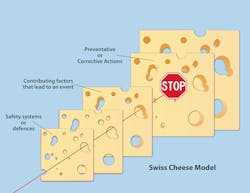SMS has raised the awareness toward the human factors hazards in maintenance. Dr. Bill sees reports on the increased use of the trusted sources from FAA’s Human Factors Website. He offers a few examples.
The regulations currently require that Part 121 operators have a safety management system well under way. That is clearly happening. The industry is embracing SMS for more reasons than mere regulatory compliance. I am noticing that the word “required” is hardly used when industry personnel talk about SMS. I see enthusiasm for the recognized value in a structured approach to spot trends and to recognize and address hazards before they cost money, injure a worker, or threaten the continuing safety of flight for airline operators.
The good news is that there is a large “trickle down” approach where Part 121 operators are asking their suppliers to establish and capitalize on a SMS. Of course, a supplier is not likely to have the same requirement for a large SMS that a 7/24/365 airline has. Each SMS is different and matched to organization needs. These organization-specific needs, in my opinion, have triggered a revised interest in maintenance human factors. I offer three examples here, which include how to categorize hazards, how to estimate return on investment, and best fatigue risk management methods and training. All of these topics are worth revisiting.
Categorizing Human Factors
Increased attention to safety management, data collection, voluntary reporting, and hazard management begs for organized categorization of hazards and errors. Over the years maintenance personnel have used the Swiss Cheese, SHELL, Bow Tie, and PEAR. Of course, I am partial to PEAR being the co-inventor and chief promoter the concept for 20 plus years. PEAR, for review, stands for People, the Environment in which they work, the Actions workers perform, and the Resources necessary to perform the work. PEAR is the main human factors training paradigm for FAA inspector training as well as for CASA Australia HF training for engineers. Training support resources are available at www.humanfactorsinfo.com as well as at the CASA website. PEAR is significant because the categories can represent the holes of error in the cheese or the human resilience represented by the solid part of the cheese. PEAR overlaps with SHELL but is easier to understand. On the Bow Tie, PEAR is an ideal way to offer the proactive barriers that prevent the event of focus.
The purpose here is not to make you a PEAR expert but it is to insist that the concept is alive and well. If you want more detail then Google “Johnson PEAR Model.”
Justifying Your Human Factors Interventions
Engineering/maintenance managers know where the most significant hazards are. Fostering the positive safety culture, using the technical publications, and ensuring fitness for duty are a few of the most common opportunities to address hazards. However, organizational-specific information, discovered by voluntary reports or SMS data will identify specific hazards, like aircraft ground movement, availability of specific tools/equipment, scheduling challenges, shift turnover communications, and more. Unlimited resources would permit organizations to address all hazards, but that’s not the real world. For that reason organizations must apply risk assessment to look at the likelihood that the hazard may cause an error and what is the severity of such an outcome. But organizations must also determine the financial and safety impact of a hazard in order to prioritize which hazard reductions have the highest payoff. That’s where the FAA Maintenance Human Factors Return on Investment tools can come in handy.
Figure 2 shows that one does not have to be an economic expert to calculate return on investment. In fact, it is more about understanding your hazards and the associated number of events (or potential events) that will result in an unmanaged hazard. SMS data can help assign costs if you are motivated to assign costs. The aviation maintenance expert will assign cost to the hazard intervention and predict the level of confidence in the estimation. The rest is multiplication and division. The tools and detailed directions are available in the tools section at www.humanfactors info.com.
Fatigue Risk Assessment
Many have seen me write or speak that SMS, regulated or not, is the best approach to fatigue management regulations in maintenance. Most authorities do not have strict rules for fatigue risk management. Even when there are national industrial fatigue rules they are usually trumped by a variety of stipulations that permit aviation maintenance personnel to work more consecutive days and longer hours than they should. Proper SMS will quickly discover if there is a maintenance fatigue issue in an organization. By design, an SMS must identify such hazards, determine the corrective action, promote the action, and assess the impact.
My recent experience suggests that industry is becoming increasingly aware of the hazards associated with worker fatigue. I believe that SMS programs have an impact on the awareness of worker fatigue hazards. The number of users on the two-hour FAA web-based training continues to grow (estimated at over 200k users in the past five years. (Course # ALC-258 available at www.faasafety.gov.) The video, titled “Grounded,” is available as part of that training or accessible on YouTube.
Demand Remains High for Maintenance Human Factors Support
Industry has stepped up to address the hazards associated with human factors challenges in maintenance. For the most part, they have done that without extensive regulations. The safety and business case speak louder than regulations. FAA intends to continue to support the maintenance human factors website and is open to all suggestions for additions to our website and associated resources.
Shell diagram, Cheese diagram, bowtie and
FAA ROI Model
About the Author

Dr. Bill Johnson
Chief Scientific and Technical Advisor Human Factors in Aviation Maintenance, FAA
““Dr. Bill” Johnson is a familiar name and face to many industry and government aviation audiences. Johnson has been an aviator for over 50 years. He is a pilot, mechanic, scientist/engineer, college professor, and senior executive during his career. That includes 16+ years as the FAA Chief Scientific and Technical Advisor for Human Factors.
Dr. Bill has delivered more than 400 Human Factors speeches and classes in over 50 countries. He has 500 + publications, videos, and other media that serve as the basis for human factors training throughout the world.
Recent significant awards include: The FAA “Charles E. Taylor Master Mechanic” (2020); The Flight Safety Foundation - Airbus “Human Factors in Aviation Safety Award” (2018), and the International Federation of Airworthiness “Sir Francis Whittle Award” (2017).
Starting in 2021 Johnson formed Drbillj.com LLC. In this new venture he continues to bring decades of human factors experience to aviators, worldwide.
